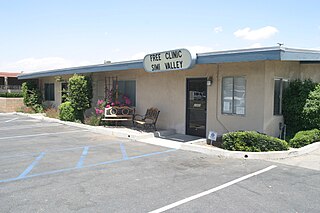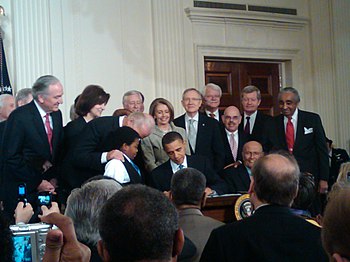
In the United States, Medicaid is a government program that provides health insurance for adults and children with limited income and resources. The program is partially funded and primarily managed by state governments, which also have wide latitude in determining eligibility and benefits, but the federal government sets baseline standards for state Medicaid programs and provides a significant portion of their funding.

The Children's Health Insurance Program (CHIP) – formerly known as the State Children's Health Insurance Program (SCHIP) – is a program administered by the United States Department of Health and Human Services that provides matching funds to states for health insurance to families with children. The program was designed to cover uninsured children in families with incomes that are modest but too high to qualify for Medicaid. The program was passed into law as part of the Balanced Budget Act of 1997, and the statutory authority for CHIP is under title XXI of the Social Security Act.

A comparison of the healthcare systems in Canada and the United States is often made by government, public health and public policy analysts. The two countries had similar healthcare systems before Canada changed its system in the 1960s and 1970s. The United States spends much more money on healthcare than Canada, on both a per-capita basis and as a percentage of GDP. In 2006, per-capita spending for health care in Canada was US$3,678; in the U.S., US$6,714. The U.S. spent 15.3% of GDP on healthcare in that year; Canada spent 10.0%. In 2006, 70% of healthcare spending in Canada was financed by government, versus 46% in the United States. Total government spending per capita in the U.S. on healthcare was 23% higher than Canadian government spending. U.S. government expenditure on healthcare was just under 83% of total Canadian spending.

Healthcare in Canada is delivered through the provincial and territorial systems of publicly funded health care, informally called Medicare. It is guided by the provisions of the Canada Health Act of 1984, and is universal. The 2002 Royal Commission, known as the Romanow Report, revealed that Canadians consider universal access to publicly funded health services as a "fundamental value that ensures national health care insurance for everyone wherever they live in the country."

A free clinic or walk in clinic is a health care facility in the United States offering services to economically disadvantaged individuals for free or at a nominal cost. The need for such a clinic arises in societies where there is no universal healthcare, and therefore a social safety net has arisen in its place. Core staff members may hold full-time paid positions, however, most of the staff a patient will encounter are volunteers drawn from the local medical community.

The Massachusetts health care reform, commonly referred to as Romneycare, was a healthcare reform law passed in 2006 and signed into law by Governor Mitt Romney with the aim of providing health insurance to nearly all of the residents of the Commonwealth of Massachusetts.

Immigrant health care in the United States refers to the collective systems in the United States that deliver health care services to immigrants. The term "immigrant" is often used to encompass non-citizens of varying status; this includes permanent legal residents, refugees, and undocumented residents.
In the United States, health insurance helps pay for medical expenses through privately purchased insurance, social insurance, or a social welfare program funded by the government. Synonyms for this usage include "health coverage", "health care coverage", and "health benefits". In a more technical sense, the term "health insurance" is used to describe any form of insurance providing protection against the costs of medical services. This usage includes both private insurance programs and social insurance programs such as Medicare, which pools resources and spreads the financial risk associated with major medical expenses across the entire population to protect everyone, as well as social welfare programs like Medicaid and the Children's Health Insurance Program, which both provide assistance to people who cannot afford health coverage.
Healthcare reform in the United States has a long history. Reforms have often been proposed but have rarely been accomplished. In 2010, landmark reform was passed through two federal statutes: the Patient Protection and Affordable Care Act (PPACA), signed March 23, 2010, and the Health Care and Education Reconciliation Act of 2010, which amended the PPACA and became law on March 30, 2010.

In the United States, health insurance coverage is provided by several public and private sources. During 2019, the U.S. population overall was approximately 330 million, with 59 million people 65 years of age and over covered by the federal Medicare program. The 273 million non-institutionalized persons under age 65 either obtained their coverage from employer-based or non-employer based sources, or were uninsured. During the year 2019, 89% of the non-institutionalized population had health insurance coverage. Separately, approximately 12 million military personnel received coverage through the Veteran's Administration and Military Health System.
Healthy San Francisco is a health access program launched in 2007 to subsidize medical care for uninsured residents of San Francisco, California. The program's stated objective is to bring universal health care to the city. Healthy San Francisco is not a true insurance program, as it does not cover services such as dental and vision care, and only covers services received in the city and county of San Francisco. The program itself acknowledges its limitations, and has stated that "insurance is always a better choice." Healthy San Francisco represents the first time a local government has attempted to provide health insurance for all of its constituents. The program is open to low-income city residents over the age of 18 who do not qualify for other public coverage, and who have had no insurance for at least 90 days. Eligibility is not conditional on citizenship, immigration, employment or health status. The program covers a range of services, but only pays providers within San Francisco. By July 2010, almost 90% of the uninsured adults in San Francisco — over 50,000 people — had enrolled in Healthy San Francisco.
In the United States, health insurance marketplaces, also called health exchanges, are organizations in each state through which people can purchase health insurance. People can purchase health insurance that complies with the Patient Protection and Affordable Care Act at ACA health exchanges, where they can choose from a range of government-regulated and standardized health care plans offered by the insurers participating in the exchange.

The Affordable Care Act (ACA), formally known as the Patient Protection and Affordable Care Act (PPACA) and colloquially known as Obamacare, is a landmark U.S. federal statute enacted by the 111th United States Congress and signed into law by President Barack Obama on March 23, 2010. Together with the Health Care and Education Reconciliation Act of 2010 amendment, it represents the U.S. healthcare system's most significant regulatory overhaul and expansion of coverage since the enactment of Medicare and Medicaid in 1965.
Healthcare in the United States is largely provided by private sector healthcare facilities, and paid for by a combination of public programs, private insurance, and out-of-pocket payments. The U.S. is the only developed country without a system of universal healthcare, and a significant proportion of its population lacks health insurance.
The community health center (CHC) in the United States is the dominant model for providing integrated primary care and public health services for the low-income and uninsured, and represents one use of federal grant funding as part of the country's health care safety net. The health care safety net can be defined as a group of health centers, hospitals, and providers willing to provide services to the nation's uninsured and underserved population, thus ensuring that comprehensive care is available to all, regardless of income or insurance status. According to the U.S. Census Bureau, 29 million people in the country were uninsured in 2015. Many more Americans lack adequate coverage or access to health care. These groups are sometimes called "underinsured". CHCs represent one method of accessing or receiving health and medical care for both underinsured and uninsured communities.
The economic impact of illegal immigrants in the United States is challenging to measure, and politically contentious. Research shows that undocumented immigrants increase the size of the U.S. economy/contribute to economic growth, enhance the welfare of natives, contribute more in tax revenue than they collect, reduce American firms' incentives to offshore jobs and import foreign-produced goods, and benefit consumers by reducing the prices of goods and services.
This article summarizes healthcare in California.
A safety net hospital is a type of medical center in the United States that by legal obligation or mission provides healthcare for individuals regardless of their insurance status or ability to pay. This legal mandate forces safety net hospitals (SNHs) to serve all populations. Such hospitals typically serve a proportionately higher number of uninsured, Medicaid, Medicare, Children's Health Insurance Program (CHiP), low-income, and other vulnerable individuals than their "non-safety net hospital" counterpart. Safety net hospitals are not defined by their ownership terms; they can be either publicly or privately owned. The mission of safety net hospitals is rather to provide the best possible care for those who are barred from health care due to the various possible adverse circumstances. These circumstances mostly revolve around problems with financial payments, insurance plans, or health conditions. Safety net hospitals are known for maintaining an open-door policy for their services.

In the context of American public healthcare policy, the Medicaid coverage gap refers to uninsured people who do not qualify for marketplace assistance under the Affordable Care Act (ACA) and reside in states that have not adopted Medicaid expansion under the ACA. People within this categorization have incomes above the eligibility limits for Medicaid set by their state of residence but fall below the federal poverty line (FPL), resulting in deficient access to affordable health insurance. As of March 2023, an estimated 1.9 million Americans in 10 states are within the Medicaid coverage gap according to the Kaiser Family Foundation. Approximately 97 percent of this cohort lives in the Southern U.S., with a majority living in Texas and Florida; Texas has the largest population of people in the cohort, accounting for 41 percent of people in the coverage gap.

Special considerations are needed to provide appropriate medical treatment for refugee migrants to the United States, who often face extreme adversity, violent and/or traumatic experiences, and travel through perilous regions. Such considerations include screenings for communicable diseases, vaccinations, posttraumatic stress disorder, and depression.











